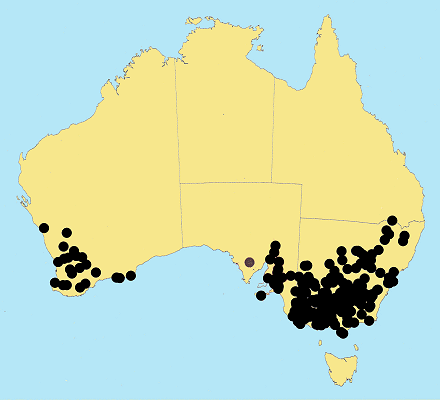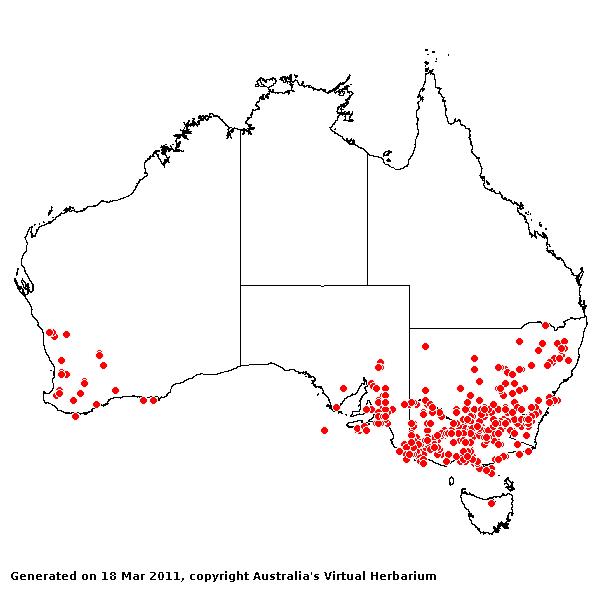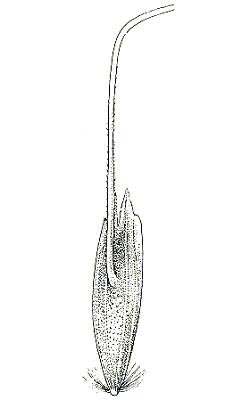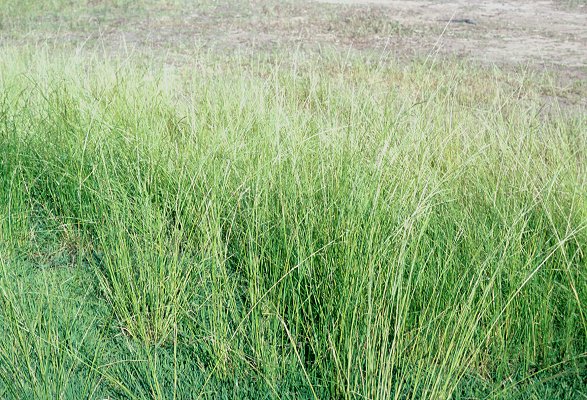Amphibromus nervosus (Hook.f.) Baill. Hist. Pl. 12: 203 (1893).
Classification. (GPWG 2001) : Subfamily Pooideae. Tribe Poeae.
Basionym and/or
Replacement Name: Danthonia
nervosa Hook. f. Flora Tasmaniae 2: 121, t. 163A. 1858.
Type of Basionym or
Protologue Information: LT: R. Brown 6622, Australia (BM, sheet with
the original label; ILT: BM). LT designated by Jacobs & Lapinpuro, Telopea
2: 721 (1986).
Key references
(books and floras): [2002] D.Sharp & B.K.Simon, AusGrass, Grasses of
Australia, [2002] J.Wheeler, N.Marchant & M.Lewington, Flora of the
South West (397), [2006] J.Jessop, G.R.M.Dashorst, F.M.James, Grasses of
South Australia (198), [2008] S.W.L.Jacobs, R.D.B.Walley &
D.J.B.Wheeler, Grasses of New South Wales (119), [2009] A.Wilson (ed.). Flora
of Australia, Vol 44A. Poaceae 2 (132).
Illustrations:
[2006] J.Jessop, G.R.M.Dashorst, F.M.James, Grasses of South Australia (198, fig. 147 & plate 6), [2008]
S.W.L.Jacobs, R.D.B.Whalley & D.J.B.Wheeler, Grasses of New South Wales,
4th edn (119), [2009]. A.Wilson (ed.), Flora of Australia 44A: Poaceae
2 (135, Fig.20), [2008] S.W.L.Jacobs, R.D.B.Whalley & D.J.B.Wheeler, Grasses
of New South Wales, 4th edn (119).
Derivation: L.
nervus, nerve; -osa, abundance. With conspicuous nerves in the
glumes or lemmas.
Habit.
Perennial. Culms erect, 60–125 cm tall, 1–3 mm diam., 2–5 -noded. Mid-culm
nodes glabrous. Leaf-sheaths smooth or scaberulous. Ligule an eciliate
membrane, 10–20 mm long, acute. Leaf-blades flat or involute, 15–30 cm long,
1.5–3.5 mm wide. Leaf-blade surface scabrous.
Inflorescence.
Inflorescence compound, a panicle. Panicle 20–40 cm long.
Spikelets.
Spikelets pedicelled. Fertile spikelets many flowered, with at least 2 fertile
florets (4–6), comprising 4–6 fertile floret(s), with a barren rachilla
extension or with diminished florets at the apex, oblong, laterally compressed,
10–16 mm long.
Glumes. Glumes
similar, thinner than fertile lemma. Lower glume lanceolate, membranous,
keeled, 1-keeled, 1–3(–5) -nerved. Upper glume lanceolate, (3.1–)4.5–6.2(–6.7)
mm long, membranous, keeled, 1-keeled, 3–5 -nerved.
Florets.
Fertile lemma 5–7.2 mm long, without keel, 5–7 -nerved. Lemma apex dentate,
awned, 1 -awned. Median (principal) awn dorsal, 12–22 mm long overall, with a
twisted column. Column 4–8.5 mm long. Lodicules present. Anthers 3. Grain
1.36–2.15 mm long.
Continental
Distribution: Australasia.
Australian
Distribution: Western Australia, South Australia, New South Wales,
Victoria.
Western Australia:
Austin. Irwin, Drummond, Dale, Menzies, Warren, Eyre, Roe, Avon, Coolgardie. South
Australia: Flinders Ranges, Eastern, Eyre Peninsula, Northern Lofty,
Murray, Yorke Peninsula, Southern Lofty, Kangaroo Island, South-eastern. New
South Wales: Central Coast, Northern Tablelands, Central Tablelands,
Southern Tablelands, North-Western Slopes, Central-Western Slopes,
South-Western Slopes, North-Western Plains, South-Western Plains, South Far
Western Plains. Victoria: Gippsland Plain, Grampians, Midlands, Murray
Mallee, Wilsons Promontory, Riverina, Volcanic Plain, Wannon, Wimmera.
Notes.
Closely resembling A. neesii, but distinguished by the awn, which arises
from lower on the back of the lemma, the usually more scabrous lemma and the
broader lemma apex.
Endemic. In southern
mainland Australia. Swamps, floodplains and banks of inland rivers of southern
mainland Australia. Flowers in response to rain or flooding.





